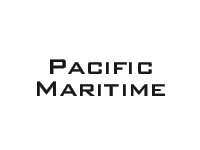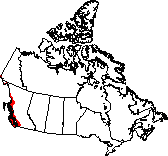|
Location
| Climate | Geology and geography
| Flora and fauna | Humans | Images
Location
The Pacific Maritime ecozone lies along British Columbia's coast and
its border with Alaska.
Climate
The Pacific Maritime ecozone is Canada's western coastline. Here is
where one finds the wettest weather, tallest trees, and deepest fjords
in the country. Being so close to the Pacific Ocean, the climate is
extremely altered. Summers are cooler, winters more mild. Summer temperatures
average 13ļC, while winters average -1.5ļC; there is less difference
between winter and summer temperatures here than elsewhere in the country.
The mountains block most of the precipitation that clouds would bring
to the interior, so precipitation can exceed 4000 mm a year in the north,
although some areas get far less than that. The Gulf Islands in the
south by contrast receive only 600 mm a year.
Geology
and Geography
The Coast Mountains rise steeply from the fjords and channels on the
coast, and glaciers are found at higher elevations. These mountains
are still young, and even where they are not very tall, as on the Queen
Charlotte Islands and Vancouver Island, they are still extremely rugged.
As part of the "Ring of Fire" that surrounds the Pacific Ocean, magma
is close to the surface here. Instead of dangerous volcanoes, hot springs
are the rule.
Flora
and Fauna
Plants
The rainfall and mild temperatures lead to record-breaking trees, both
in size and age. Temperate rain forests are common at lower altitudes,
but high altitudes lead to stunted trees, and eventually no trees at
all above the treeline. Some of the tree species found here are western
red cedar, yellow
cedar, western
hemlock, mountain
hemlock, western
yew, coast Douglas
fir, amabilis
fir, grand fir,
coast redwood,
Sitka spruce,
red alder, lodgepole
pine, western
white pine , shore
pine, Engelmann
spruce, Garry
oak, and pacific
dogwood. Other plants in the ecozone include salal, Oregon grape,
arbutus, sword
fern, skunk cabbage,
salmonberry, devilís club, western bleeding heart, red huckleberry,
old manís beard,
red elderberry, calypso orchid, and Viola langsdorfii
Animals
Mammals
Some of the characteristic large herbivores include black-tailed
deer, mule
deer, elk,
moose,
caribou
and mountain goat.
The large carnivores of the Pacific Maritime are black
bear, grizzly
bear, wolf,
and mountain
lion, Smaller herbivores such as beaver,
snowshoe
hare, American
pika, applodontia,
hoary marmot,
Vancouver marmot,
townsend chipmunk,
and chickaree
can be found here. The small carnivores include wolverine,
mink, river
otter, spotted
skunk, raccoon,
red fox,
and marten.
Aquatic mammals here include northern
sea lion, northern
fur seal, Alaska
fur seal, harbour
seal, elephant
seal, California
sea lion, giant
beaked whale, sperm
whale, grey
whale, orca, Pacific
pilot whale, and blue
whale.
Birds
Some of the characteristic birds of prey are northern
pigmy owl, northern
saw-whet owl, short-eared
owl, long-eared
owl, turkey
vulture, bald
eagle, and red-tailed
hawk. Shorebirds and seabirds that are found here include American
black oystercatcher, tufted
puffin, glaucous-winged
gull, pelagic
cormorant, spotted
sandpiper, common
snipe, pigeon guillemot,
rhinoceros auklet,
and killdeer. The
waterfowl of the region include great
blue heron, wood
duck, northern
pintail, blue-winged
teal, mallard,
Canada goose, trumpeter
swan, and sandhill
crane. Some of the songbirds that are found here are chestnut-backed
chickadee, Stellerís
jay, northwestern
crow, red-winged
blackbird, cedar
waxwing, purple
finch, brown creeper,
American dipper,
and brewer's blackbird.
The birds of the forest include California
quail, mountain
quail, spruce
grouse, ruffed
grouse, blue
grouse, Lewis'
woodpecker, band-tailed
pigeon, and downy
woodpecker.
Amphibians and Reptiles
The moist conditions of the Pacific Maritime allow many amphibians to
thrive. A few of the frog and toad species are the western
toad, red-legged
frog, pacific treefrog,
wood frog, and
tailed frog. Some
of the characteristic salamanders and newts are the roughskin
newt, long-toed
salamander, northwestern
salamander, pacific
giant salamander, western
redback salamander, and Eschscholtz's
salamander. The turtles of the ecozone include leatherback
turtle and green
turtle. Some snakes and lizards that are found here are the
garter snake, western
terrestrial garter snake, sharptail
snake, northwestern
garter snake, and northern
aligator lizard.
Fish
Pacific salmon, pacific herring, pacific halibut, steelhead, cutthroat
trout, dolly varden, rainbow smelt, peamouth, and coastrange sculpin
are some of the fish that live here. Some of the species that enter
freshwater to spawn are western brook lamprey, pacific lamprey, river
lamprey, green sturgeon, white sturgeon, pink salmon, chum salmon, coho
salmon, and sockeye salmon.
Molluscs
The oval lake-limpet,
western-river
pearl mussel, western
floater and arctic-alpine
fingernail clam are some of the molluscs that live here.
Insects
A few of the insects that are found here are red
turpentine beetle, Nicrophorus
sayi, European
earwig, spring
azure, American
copper, monarch
butterfly, mourning
cloak, and migratory
grasshopper.
Humans
Human activities have an enormous effect on the Pacific Maritime ecozone.
Two and a half million people live in this ecozone, and the population
continues to grow by leaps and bounds. The resulting urban growth has
severely strained ecosystems in the areas around the major urban centres.
Forestry also threatens many systems and overfishing does much the same
in the coastal waters.
Images
Rainforest, Queen Charlotte Islands, British Columbia
Salmon Glacier, near Stewart, British Columbia
Salmon Glacier, near Stewart, British Columbia
 

|
|







